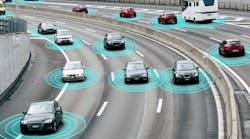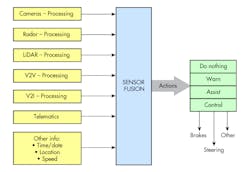Download this article in PDF format.
The modern automobile is simply loaded with electronics. From basic conveniences like power seats, windows, and mirrors to the latest advanced driver-assistance systems (ADAS), the automobile has become a major electronics platform. Missing from this electronics collection is some form of wireless connectivity to the external world.
Yes, many of today’s vehicles do include wireless such as AM, FM, and satellite radio; GPS navigation; and Bluetooth connectivity. Some even offer a Wi-Fi hot spot. However, cars don’t communicate with one another or with any infrastructure. That neglect is about to be remedied—more wireless connectivity is on the way.
Sponsored Resources:
- Where we’re going with the connected car
- How connectivity is driving a reimagined future for cars
- Paving the way to self-driving cars with ADAS
Telematics Today, But What About Tomorrow?
One connectivity feature showing up in newer vehicles is telematics. Telematics is basically just the wireless transmission of specific types (e.g., sensor) of data. In vehicles, telematics usually transmits GPS location data by way of the cellular system. It’s widely used on trucks and fleet vehicles to track their location and condition. It’s also found in cars, but isn’t as widely implemented in that space as of yet. The most well-known example is GM’s OnStar. Telematics employs a GPS receiver and a basic cellphone to report a vehicle’s location and to signal an accident. Other features are things like remote door unlocking and emergency service.
In Europe, all new cars after April 2018 must have eCall, a service that gives GPS location via a cellular connection. It reports an accident and provides a service in an emergency. This mandated feature requires that all new cars have a telematics control unit (TCU) with a GPS receiver, cell phone, and MCU with various sensors and controls. Such a feature may become a formal requirement in the U.S. In the future, that TCU will no doubt interact with other electronic systems within the car, including the ADAS.
Today, a typical TCU can often be implemented with a handful of chips such as the MCU, all radios (GPS and GSM cell phone), and necessary I/O. A mandated requirement is that a separate backup battery be included to operate the TCU in the event of an accident or some situation where the car’s main battery is incapacitated. A lithium-ion battery is the most logical choice. Add to that the battery protection and management and any related regulators, chargers, or dc-dc converters needed.
Connectivity and the ADAS
While ADAS has been an option on most cars for years, today it’s becoming standard equipment. It has proven itself to drivers who benefit from the automatic controls and alerts. The typical ADAS consists of a backup camera, radar for adaptive cruise control and automatic braking, lots of video cameras, and ultrasonic sensors that implement lane keeping and other collision avoidance systems. No connection currently exists between the telematics and ADAS.
On the horizon is the incorporation of vehicle-to-vehicle (V2V) and vehicle-to-infrastructure (V2I) radios. These subsystems let the car talk to other vehicles nearby automatically or to communicate with city, county, or federal services that can provide useful data to the driver. The main goal of V2V and V2I is safety. V2V will prevent cars from colliding with each other. V2I will give drivers information like road conditions, construction, weather, and traffic that will help them avoid delays and accidents.
The two competing wireless technologies are dedicated short-range communications (DSRC) and cellular-based V2X, where X refers to other vehicles, the infrastructure, or other entities. DSRC is the older of the two technologies and is based on a version of Wi-Fi. It’s an IEEE standard 802.11p and uses the 5.9-GHz ISM band. Range is about 1000 feet maximum. The system transmits key information such as car location, direction, speed, turn status, and braking condition 10 times a second. Other nearby vehicles will receive it and react to it. Such a system will be tied to the ADAS, allowing for automated reactions to avoid a collision.
The C-V2X system is similar, but it uses the existing cellular system for the V2V connection. C-V2X is based on the current LTE cellular standards and would also use the 5.9-GHz band. It includes a feature called PC5 that enables direct V2V connections in addition to its cellular coverage. Overall range is greater than that provided by DSRC. It, too, will be attached to the ADAS that will allow automated braking or steering actions to avoid collisions.
The V2V and V2I systems haven’t been mandated by the government—that’s expected to happen in the future, though. For now, DSRC and C-V2X are competing for the standard to be adopted. C-V2X could be the ultimate winner given the current discussions within the industry. In the meantime, the auto industry is contemplating the role of the forthcoming 5G wireless system. What is its role, if any? The C-V2X system does incorporate a migration path to the 5G standards when it emerges.
The Secret to ADAS Success
The key to expected ADAS performance lies with the sensors on the vehicle and the system’s ability of the system to correctly interpret these inputs and translate them into warnings or actions (see figure). The primary sensors today are the radar and the video cameras. The light detection and ranging (LiDAR) sensors are currently too expensive, but prices and size are expected to decrease considerably in the coming years. Not shown are the ultrasonic sensors and infrared (IR) cameras.
Future advanced driver-assistance systems (ADAS) will incorporate an array of communications technology.
Each sensor sees the surrounding in a different way. Radar and LiDAR see in the dark and through rain and snow—video cameras do not. But video cameras see in more detail and in color. IR cameras can see in the dark, though. The combination provides redundancy and variety to build a picture as close to reality as possible.
The outputs of these sensors must be combined and interpreted to extract the knowledge they provide. Standard processors provide some sensor preprocessing; however, more advanced analysis is needed to make sense of the inputs. This is the job of the sensor fusion block, which is essentially heavy-duty computing power that includes DSP, artificial intelligence, and machine learning. Once analyzed, in real time, the system then provides warnings, assistance, or action in the form of braking or steering. Now add to that system-communications inputs from V2V and V2I radios and further processing will be needed. The overall result will be a more powerful driver assist as well as the basis for the full driverless car.
The Autonomous Vehicle
Autonomous vehicles (AVs) will use all of the current ADAS subsystems plus some new versions. And V2X connectivity will be a part of that. AV development has been frantic, but most signs point to full roll out and acceptance being many years off. Improvements in sensors like LiDAR, mapping, and machine-learning AI processing are still needed to make AVs safe. Electronics will be the deciding factor in the success of AVs and connectivity will be a major necessity in AV safety. Don’t forget that the path to the AV also includes more processing power, lower power consumption, and faster inter-vehicle networking.
Semiconductor manufacturers are working to improve devices for better in-vehicle networking like Ethernet, to boost processing power, and to perfect vehicle power management. A major focus is the video sensors and related processing power. Integrating more of these devices into larger-scale systems-on-chip (SoCs) will significantly improve not only performance, but also reduce costs. An example is combining higher-resolution video cameras with on-chip RISC and DSP MCUs, as in Texas Instruments’ TDAxx SoC. It will be a while before self-driving cars emerge. In the meantime, ADAS keeps getting better, further improving safety and paving the way for AVs.
Sponsored Resources:


